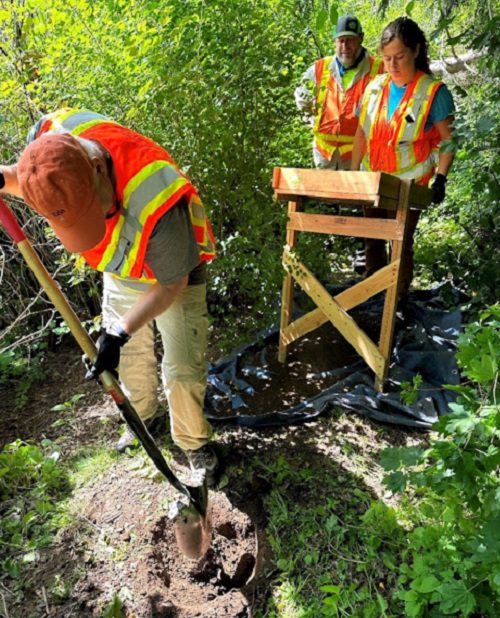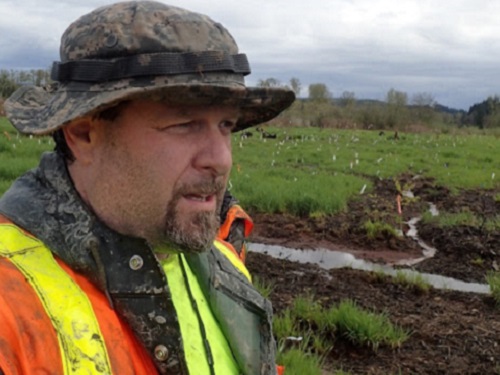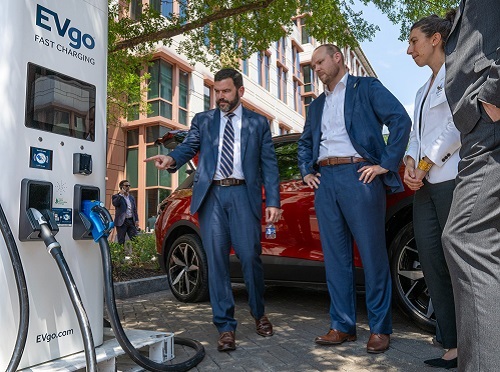A recent blog post from the Washington Department of Transportation illustrated the important connections between the sciences of archeology and transportation infrastructure construction.
[Above photo of Jason Cooper by WSDOT]
Federal and state laws mandate that all transportation projects, particularly ones that disturb the ground, be evaluated for their effects on cultural resources. WSDOT goes a step further with a policy commitment to avoid, minimize or mitigate its adverse impacts on “cultural resources” – which include areas, structures, and objects that are at least 50 years old – and help preserve such historical finds as well.
Enter Jason Cooper, WSDOT cultural resources lead. A veteran archeologist with 32 years of experience, Cooper has spent the last six working for WSDOT and leads a team that studies human history and pre-history on and below state roads and waterways, helping WSDOT construction and environmental teams preserve culturally important places.
WSDOT’s cultural resources team also works closely with tribes in Washington, Oregon, and Idaho, along with cities and counties across the state to preserve things like historic bridges and landmarks, archeologically and anthropologically sensitive sites and spaces/things of cultural significance. WSDOT noted that they research, for example, whether a highway project might trample on old tribal burial grounds or anything else of historical value.

Cooper explained in the blog post that he is “driven by the belief” that every artifact, no matter the size or shape, has a story to tell and that his team’s cultural resources work provides valuable insights into the lives of “those who came before us.”
After getting a bachelor of arts in history and minor in anthropology at San Diego State University – and later a master’s in anthropology from the University of Nevada-Las Vegas – Cooper worked on archeological excavations in the U.S. and worldwide spending time in in Jordan and Cyprus studying the Neolithic period (some 6,000 years before today) and, in Egypt, focused on old stone age, early “hominid” survey work. Hominids are all modern and extinct Great Apes, Cooper noted – that is, modern humans, chimpanzees, gorillas, etc., plus all their immediate ancestors.
Cooper noted that the WSDOT cultural resources team operates on a three-part system as part of the pre-planning process for transportation construction work. The work entailed by those steps includes:
- Identification: Before any large-scale ground disturbance is planned, Cooper and his team identify areas with possible archeological significance through desktop research (checking maps, combing through archives, reading books, scanning online records, etc.) and surveying (digging holes or test probes to examine a site). Frequently, Cooper and a team of subcontractors will do several shovel probes of the ground. Sometimes only a few dozen probes are dug, other times there can be hundreds or thousands.
- Evaluate: Next, WSDOT archeologists and subcontractors evaluate by screening the soils removed from these test probes or holes to see if they find anything historical or “pre-contact” – a term used to describe times before Europeans arrived and contacted Native Americans already living in North America.
- Determine for Eligibility: Cooper and his team determine if any items found during the digging process are eligible as an archeological finding. If so, he writes reports on which the culture the artifact/object belongs to and next steps, such as returning it to the ground, relocating the construction project or finding a new home for the object.
WSDOT noted that while this three-step system typically takes place before ground is disturbed, it can take place at any time, particularly if something unusual is discovered by our crews during excavation.
As an aside, WSDOT’s Cooper has written more than 150 cultural resources reports for Washington State alone and has come across “numerous” interesting archeological discoveries, such as:
- In 2022, as part of a debris flow project on SR 410 near Crystal Mountain Resort where the washed-out road was repaired, Cooper and his team studied if the temporary repairs would affect cultural resources after the Nisqually Tribe requested a survey. During the work, Jason’s team found pre-contact impacts (such as a piece of a stone tool), culturally modified trees (a tree Native Americans had removed bark from) and a segment of the old McLellan Highway, which was the old state route to Crystal Mountain.
- While new culverts were being installed under SR 169 between Renton and Maple Valley in 2021, Cooper was brought in after on-site crews discovered a long section of buried wood planks. He determined the planks belong to an original road built by King County in the 1920s between Renton and Maple Valley.
- Recently, at the I-90/SR 18 Deep Creek Interchange Improvements project work site near Snoqualmie, a bone was discovered by work crews. Cooper was able to determine the bone likely came from a quadruped/ungulate (likely elk) and was not human – and that quick determination helped keep the project on schedule, WSDOT added.
- While the tree is no longer there as of July 2023, five years ago Cooper determined that a willow tree on Seattle Housing Authority land near I-5 and James Street was a cloned descendant of a willow tree that is near the French dictator Napoleon’s grave site at St. Helena’s Island.
- Historical records determined the site of SR 92 roadwork near Granite Falls likely had archeological sites, so the road was routed around the city instead through those sites. Cooper – at the time still an on-call consultant – and his team found thousands of human-made artifacts – human manufactured stone tools, arrow heads, cutting devices, etc. – many of them thousands of years old. The sites were part of the Olcott archeological sites, which predates the first known pyramids in Egypt.
Other state departments of transportation are engaged in a variety of archeological endeavors as well.
For example, in October 2022, the Kentucky Transportation Cabinet helped establish a new website highlighting more than 100 prehistoric and historic archaeological sites across the state’s 64 counties. KYTC launched the new website – Discover Kentucky Archaeology – in collaboration with the Kentucky Heritage Council-State Historic Preservation Office, an agency of the Kentucky Tourism, Arts, and Heritage Cabinet.
And in January 2022, the Colorado Department of Transportation debuted a documentary called “Durango 550 – Path of the Ancestral Puebloans” to show how the agency worked with archaeologists and regional Native American tribes to document, study, and ultimately share the discoveries unearthed near Durango in southwest Colorado. That archaeological excavation took place in 2018 and 2019 ahead of construction on the US 550-US 160 Connection South project in 2020.


